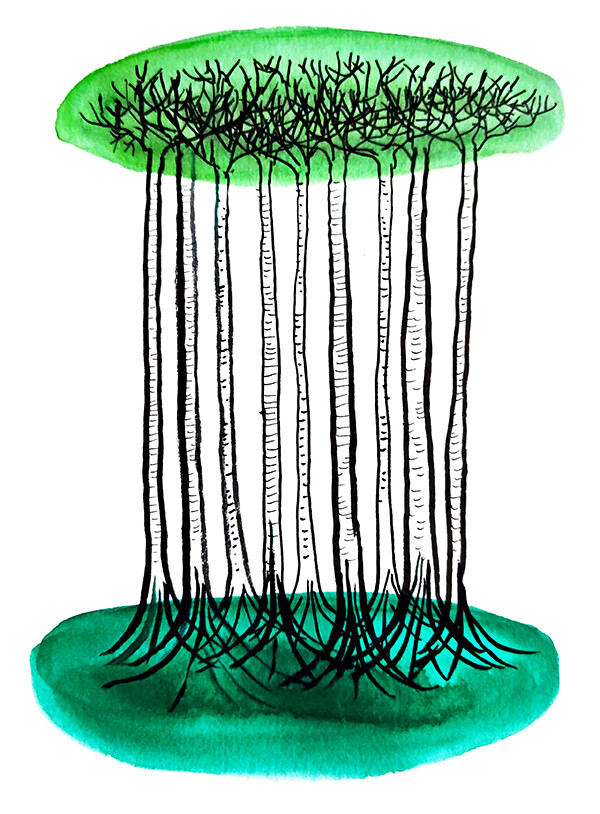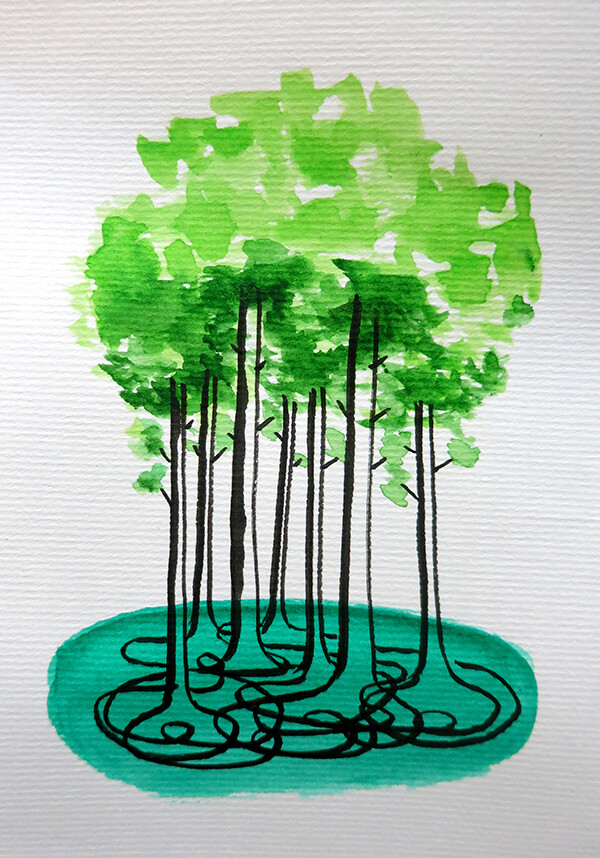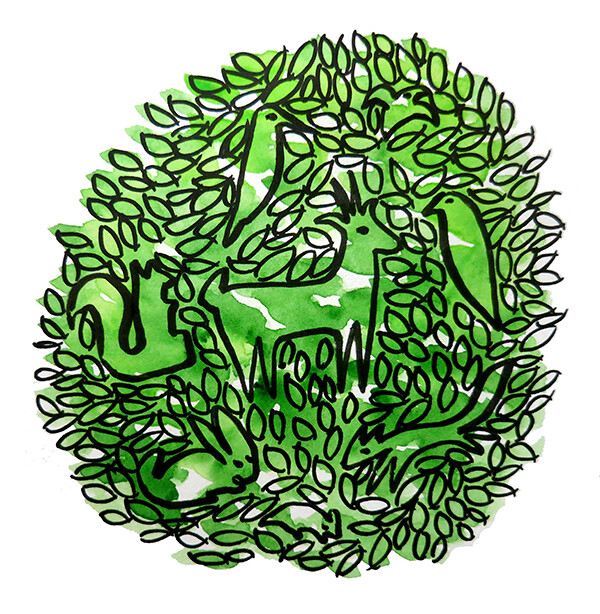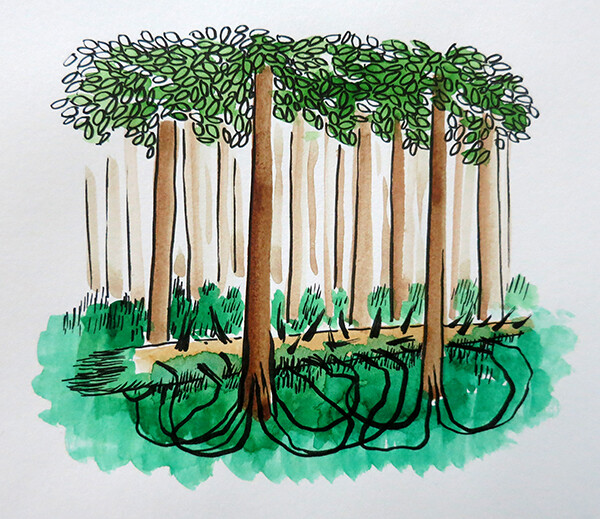1.
Since growing up in a small village in the south of Slovenia in the 1970s, I have always been surrounded by forests. Our family has “owned” forests for generations, my father and my siblings have studied forestry, and my grandmother was known in the village for her herbal medicine skills. My father was one of the researchers of the Pečka virgin forest nearby, a very special reserve that includes majestic fir and beech trees. For us, back then, forests were not scary places where one would get lost or die. Throughout history, forests have provided an abundance of food and resources: berries, nuts, mushrooms, beech juice, and animals too. Forests have always been a kind of refuge, for humans and nonhumans alike. During the Second World War, forests protected Yugoslav partisans who were fighting for freedom against the occupying forces. Partisans built hospitals and schools, printed books, and even organized art events in the forests, which provided them with shelter and privacy. There was a special comradeship between forests and partisans; it is not a coincidence that a famous partisan hymn begins: “In the forests and the mountains of our proud country, partisan troops are marching, spreading the glory of struggle!”
About a decade ago, in a place distant from Slovenia, the writer Arundhati Roy spent some time “walking with comrades” through the dense forests of Dandakaranya in central India.1 These comrades were a troop of indigenous rebels hailing from the Gond, Halba, and Muria tribal communities, and they were fighting state-backed exploitation, including the destruction of forests, lands, and water. Roy describes how the Indian state’s “institutionalizing [of] injustice” affected these groups. The Dandakaranya forest has been a highly contested space for decades, because the corporate appetite for minerals and other resources remains limitless. The tribal communities of the Dandakaranya forest, as well as the tribal communities of the Amazon like the Kayapo, the Arara-Karo, and many others, have been defending rainforests for a long time. Many indigenous people living in forests have a specific relation to nonhuman life there; often they do not distinguish between humans and nonhumans. For these communities, deforestation means losing not only their ancestral home, but also their source of knowledge. The communities living in close relation with these woodlands are aware that, by exploiting forest resources, it is not only human lives that are ruined, but all other life that depends on the forest.
Humans that are closely entangled with nonhuman environments and attentive to nonhuman life do not need to theorize about any nature-culture division. For others, the concept of nonhuman life and the idea of a more equal or just relation to it causes considerable difficulties. Recent criticism has focused on the way nonhumans are included in discussions of nature, ecology, and climate change. This critique says that speaking for the nonhuman is unproductive, and thinking on their behalf only supports existing humanist ideologies that anthropomorphize and patronize other species. Astrida Neimanis, for one, has written about the ways that nonhuman “others” are represented. She proposes a “representation without colonization,” pointing to the questionable ethics and politics of humans who position themselves as spokespeople for nonhuman beings.2
Other critics claim that in the current political situation, with the rise of fascism, human-rights violations, new wars, displacement, and migration, times are not ripe for discussions on nonhuman life. With the pandemic, it has become clear that humanity itself is in deep trouble; perhaps humans must first solve their own problems. But the problems of humans are the problems of nonhumans, and vice versa.
As the inhabitants in India’s Dandakaranya forests and many other communities living close to forests have always known, everything on the planet is intertwined, and life in all of its dimensions cannot be separated—humans from nonhumans, nature from culture, object from subject, mind from body. As a child I was taught that every single species, even the smallest, has a place in the forest, and humans have no right to destroy that ecological equilibrium. There is no good or bad in the forest; everything there is just the way it should be, and there is no need for human intervention. This is especially the case with virgin (old-growth) forests. Dušan Mlinšek, a forest researcher from Slovenia, spoke in the 1980s about the “true nature of a forest.” For him, this “true nature” could be best observed in a virgin forest, an ecological space eternally growing in cyclical patterns, where death and life are intertwined. In other forests where humans have intervened, such cycles are not so visible, since dead trees are cleared and new trees planted. In an old-growth forest, a dead tree can be more abundant with life than a living tree. A forest is not the sum of its tree-parts. It is more than that: an ecosystem based on complex, intertwined relationships among plants, animals, fungi, bacteria, and other organisms.
We need to learn from trees and forests. We need to practice a politics of solidarity with nonhumans. Of course, there are always difficulties with terminology when discussing nonhumans, and “solidarity” in this context might even sound politically problematic. However, this solidarity is not from “above”; it’s not pity, sympathy, or Christian love. Rather, it is the kind of solidarity that reaches across racial, class, gender, generational lines, and also across the human-nonhuman divide—the solidarity of “being present in the other.”3 One example of this kind of solidarity is recent multispecies ethnographic research, which enables humans to envision new ways to comprehend nonhumans. Without this understanding, the only common ground that humans and nonhumans will have is a planetary future without us.4


Djordje Balmazović, from the series “More-Than-Human Collectives,” 2021.
2.
“We are tired of trees. We should stop believing in trees, roots, and radicles.”5
Deleuze and Guattari wrote these lines in A Thousand Plateaus, in a paragraph concerning a longstanding model of knowledge as hierarchical and tree-like. This model contrasted with the authors’ own notion of rhizomatic knowledge. Trees, at least as a philosophical construct, were not something Deleuze and Guattari held in high esteem. They believed trees were ontologically vertical and thus could not represent nonhierarchical knowledge.
The other knowledge they spoke of—rhizomatic knowledge—concerned trans-species connections, but was still knowledge produced by and for the human species. To paraphrase Anna Tsing: that is actually a limitation, as “we will never have a chance to become trees.”6 It is less difficult than it may seem to bridge the divide between species. Much recent research has shown that trees have much more in common with human and nonhuman species than previously thought.
The relationship between nature and culture, and the so-called division between them, has been a major subject of debate throughout Western history. This endless analysis and negotiation has even been regarded as a kind of “conceptual prison.”7 In the Western tradition, this dualism is for the most part rooted in Enlightenment rationalism, where nature is considered “other” in relation to culture. Many thinkers have recently challenged this assumption, through terms like “transversality” nature-culture “hybridity.”8 Donna Haraway’s notion of “making kin” with the more-than-human world takes account of the gendered and racialized aspects of the nature-culture dichotomy.9 Neimanis writes about “flat ontology,” where nature and culture are flattened into one, which is both destabilizing and liberating.10
Who is actually given the privilege to speak in the name of nature(s)? What is the right way to “represent” the thing we call “nature”?11
What, or even who, is a tree?


Djordje Balmazović, from the series “More-Than-Human Collectives,” 2021.
3.
A paradox: in order to preserve nature, humans must protect it, which in many cases means making it inaccessible to other humans—often at the risk of social injustice. Nature reserves around the world are usually based on Western ideas of appreciating nature. These reserves can have adverse consequences for local inhabitants, such as displacement, limiting access to resources, and consequently pushing them into poverty. At the same time, nature is at risk of total destruction at the hands of massive corporations like Rio Tinto, British Petroleum, and Exxon Mobil, which regard nature solely as a source of raw material. Forests continue to be cleared, minerals continue to be extracted, and destructive practices like monocropping continue to expand, which in turn causes pollution, the extinction of plants and animals, and poverty and disease among humans.12 A recent report concludes that humans are driving up to one million plant and animal species to extinction, at a rate hundred of times higher than the average rate of extinction over the past ten million years.13
Today more than 10 percent of the eighty thousand tree species that have been identified are endangered. At least seventy-seven tree species have become extinct in the past hundred years, and over six hundred plant species have gone extinct in the past two hundred and fifty years. The extinction rate is five hundred times faster than the rate at which plants would be disappearing without human influence.14 In the Amazon rainforest alone, if deforestation continues at the current rate, more than half of the fifteen thousand tree species there will likely become extinct.15
Who is to blame for this destruction? Is it humanity in general, with its ever-increasing material needs satisfied by expanding capitalist production? Or is it the rich and the powerful, who are most responsible for resource extraction? Andreas Malm argues that we need a new politics of nature and ecology—an antagonistic politics—if the current trajectory of extinction and destruction is to be changed. Species-thinking on climate change only induces paralysis, asserts Malm.16 What he means is that the mainstream narrative on ecological destruction, which naturalizes the capitalist mode of production, implies that all of humanity is equally responsible for the destruction of life on the planet, when it is economic elites who consume the most resources by far.
Slavoj Žižek similarly argues that ecology is one of today’s major ideological battlefields. The nature we encounter, he writes, is always already caught in an antagonistic relationship with human labor.17 Naomi Klein has argued that climate justice should become an aspect of social justice.18 This move has the potential to change the meaning of both “social” and “justice.” Capitalism prevents any kind of meaningful ecological action simply because it is not profitable. As long as discussions on climate change are attuned to the interests of capital, no significant change will happen.
4.
Many human societies have always had a special relationship with trees, plants, animals, and other nonhuman kin. To take trees as an example, people have not only depended on trees for shelter, fuel, and food, but also for medicine and spiritual fulfillment. In many cultures around the world, trees represent an important aspect of communal life; in villages throughout Africa, elders discuss important matters under particular trees, such as baobabs in Madagascar. Until quite recently, in Slovenia the linden tree symbolized the central space of village communities. In traditional Japanese culture, tree spirits, or kodama (first mentioned in the eighth-century Kijiki chronicle), and holly trees, or shinboku, still play an important role in cultural life. Not only are these trees protected in Japan, but knowledge of the trees that kodama inhabit is very important for many communities, being passed from one generation to another. Trees have also sometimes been declared monuments, signifying important sites, events, and even people.
We cannot say that trees are actually aware of the monumentness imposed on them by humans. The same goes for other human concepts applied to trees, such as “history”—do trees have history beyond their human-made ones? What could that history be other than the genetic changes trees have undergone since the first Archaeopteris species of proto-tree arose more than three hundred million years ago? What is certain is that trees are without a clear division between life and death, between the present and future, at least not in the same way humans understand these concepts.
A forest is a complex community where trees make up only a portion of the many species. There are different kinds of forests on the planet, from primeval, old-growth forests to commercial forests. Old-growth forests are very diverse, with old and young trees of varying heights clustered unevenly throughout the forest. Such forests are self-sustaining, while commercial forests need constant help from the outside.19
Unlike humans under capitalism, trees are not individualistic beings driven by greed to compete with each other for space and resources. Fully grown trees support young seedlings in a shaded understory, while dying trees provide resources for living trees, as well as for fungi, bacteria, bugs, birds, bears, and many other species. When in danger—from insect attack or disease, for example—trees also send out distress signals to other nearby trees. Apparently, the trees synchronize their behavior so that they are all equally successful and the rate of photosynthesis is the same for all.20 A group of researchers working in the southwestern Pyrenees recently discovered a complementary relationship between different tree species—for example, between pine and beech trees, where growth of both is reduced when intraspecific competition increases.21 They also noticed that during extreme drought, the number of individual trees may decrease, but tree communities share resources to stay alive.
Scientists have noticed that it is very difficult to distinguish what is actually part of a tree and what is not, as different species crossbreed more than originally thought. Trees form hybrid collectives, involving underground mycorrhizal fungi networks that connect trees, roots, and fungi to one another in a kind of collaborative, self-organized way. This complex assemblage has been termed the “wood wide web.”22 These networks distribute sugar, nitrogen, and phosphorus among trees; some of these networks may be up to 450 million years old. Trees that have access to this network do better; for example, trees connected to mycorrhiza have a higher rate of survival under drought conditions. Suzanne Simard, a leading forest researcher, has pointed out that these networks also have “hub” trees, or “mother” trees, which can be connected to hundreds of other trees.23 Cooperation over self-interest helps tree communities thrive.
Forest ecosystems have been affected by trade and transoceanic voyaging for centuries through the introduction of so-called invasive or alien species. Recently the name “new wild” has been used for ecologies created by species that migrate across the globe, losing their habitats and adapting to new ones. Nonhuman migrants and their impacts on ecosystems can be evaluated in a number of ways. Apart from traditional approaches, which monitor and quarantine pests and harmful organisms, repairing the damage in native forests, more recent approaches are based on different principles, such as critical environmental ethics. The field of environmental ethics explores the relationships between humans and nature, the intrinsic value of nature, and the consequences of anthropocentrism—in other words, the “ethical framings of forest health.”24
There are three ethical frameworks often mentioned in the context of environment ethics.25 “Biocentrism,” developed by Paul Taylor, is a classic approach to forest health management based on a “respect for nature.” One tenet of biocentrism is “to avoid restricting the freedom of individual organisms to act and develop in their own way.” A second framework, called “entangled empathy,” concerns the relationship between parasites (pests, harmful organisms) and hosts (trees)—the disease-causing and the diseased. Developed by Lori Gruen, entangled empathy is an experimental approach focused on “attending to another’s experience of well-being,” where humans and nonhumans are intertwined in an active relationship, and where breaking those ties would mean that “our lives would no longer make sense.” The third concept is “flourishing,” based on the work of Angela Kallhoff, which sees plants as “holding moral status due to their ability to flourish.” This approach seeks to grant an ethical status to nonhumans without anthropomorphizing them.
Dipesh Chakrabarty argues that life on this planet also involves the histories and activities of microbial forms of life, of bacteria and viruses, many of which are not friendly to the human form of life.26 Zoonotic pathogens (such as SARS-CoV-2) that spread among humans do not act intentionally, but in response to the disturbance and destruction of their natural ecosystems. One of the primarily reasons for viral outbreaks in recent years is deforestation (especially of tropical forests), which leads humans to come into contact with “wild” animals, which carry pathogens. But even the idea of “wild” is wrong in this context; it is a construct of human colonizers who believed they had a right to take land from native inhabitants. That’s why it’s so important to support the indigenous defense of land and forests. In addition, trees are our allies in climate crisis; studies have shown that each year forests absorb between 10 and 15 percent of worldwide carbon emissions. For this reason, 11 percent of global greenhouse gas emissions can be traced back to deforestation and forest degradation account for.27 The logic is very simple: if forests are destroyed, all life on the planet will sooner or later be gone too.
How do we become better at recognizing “more-than-human” modes of life without anthropomorphizing nonhuman life? How do we practice care, freedom, justice, and equality with nonhumans? How do we mobilize a broad front to demand more just environmental politics?
We should never grow tired of trees, as Deleuze and Guattari did. On the contrary, we should embrace trees. We should speak for them and for nature, “not only in spite of but because of the impossibility of the task, even if it is always destined to fail,” as Neimanis writes.28 Realizing that representation can never really be bypassed—we can only speculate about “nature writing itself”—is a crucial part of understanding nonhuman beings and our relationship to them.
Arundhati Roy, “Walking with the Comrades,” in the pamphlet series “Essays for Discussion,” Kasama Project.
Astrida Neimanis, “No Representation without Colonisation? (Or, Nature Represents Itself),” Somatechnics 5, no. 2 (September 2015).
Manuel Borja-Villel, introduction to “Commons/Solidarity” seminar (“Glossary of Common Knowledge” conference, L’Internationale and Moderna Galerija, Ljubljana, June 23, 2020).
See Dipesh Chakrabarty, “The Climate of History: Four Theses,” Critical Inquiry 35, no. 2 (Winter 2009): 197.
Gilles Deleuze and Félix Guattari, A Thousand Plateaus: Capitalism and Schizophrenia (University of Minnesota Press, 1987), 15.
Anna Tsing, “More-than-Human Sociality: A Call for Critical Description,” in Anthropology and Nature, ed. Kirsten Hastrup (Routledge, 2013), 34.
Yrjö Haila, “Beyond the Nature-Culture Dualism,” Biology & Philosophy, no. 15 (2000), 158.
See Bruno Latour, We Have Never Been Modern (Harvard University Press, 1993).
See, for example, Donna Haraway, “Making Kin,” interview by Steve Paulson, Los Angeles Review of Books, December 6, 2019 →.
Neimanis, “No Representation without Colonisation?” 149.
See Eduardo Kohn, “A Conversation with Philippe Descola,” Tipití: Journal of the Society for the Anthropology of Lowland South America, 7, no. 2 (2009).
See Donna Haraway, Staying with the Trouble: Making Kin in the Chthulucene. Duke University Press, 2016.
See →.
Scientists have also concluded that in the centuries leading up to the year 1900, 256 seed species became extinct. Between 1900 and 2018, the number was 315. See Aelys Humphreys et al., “Global Dataset Shows Geography and Life Form Predict Modern Plant Extinction and Rediscovery, Nature Ecology & Evolution, no. 3 (2019): 1043.
Damian Carrington, “Half of Tree Species in the Amazon at Risk of Extinction, Say Scientists,” The Guardian, November 20, 2015 →.
Andreas Malm, “The Anthropocene Myth,” Jacobin, March 30, 2015 →.
Slavoj Žižek, “Ecology against Mother Nature,” Verso blog, May 26, 2015 →.
Naomi Klein, This Changes Everything: Capitalism vs. the Climate (Knopf, 2014).
Dušan Mlinšek, Pra-gozd v naši krajini (VDO Biotehniška fakulteta, 1989), 48.
Peter Wohlleben, “How Trees Send Out News Bulletins,” Sydney Morning Herald, September 6, 2016 →.
Ester González de Andrés et al., “Tree-to-Tree Competition in Mixed European Beech–Scots Pine Forests Has Different Impacts on Growth and Water-Use Efficiency Depending on Site Conditions,” Journal of Ecology, June 15, 2017 →.
First discovered by Suzanne Simard in 1997 and published in the journal Nature the same year →.
Susanne Simard, “How Trees Talk to Each Other,” TED Talk, July 2016 →.
Norman Dandy, Emily Porth, and Ros Hague, “Environmental Ethics of Forest Health: Alternative Stories of Asian Longhorn Beetle Management in the UK,” in The Human Dimensions of Forest and Tree Health: Global Perspectives ed. J. Urquhart, et al. (Springer International Publishing, 2018), 420.
The information in this paragraph is drawn from Dandy, Porth, and Hague, “Environmental Ethics of Forest Health,” 425–37.
Dipesh Chakrabarty, “Whose Anthropocene? A Response,” in Whose Anthropocene? Revisiting Dipesh Chakrabarty’s “Four Theses,” ed. Rober Emmett and Thomas Lekan (RCC Perspectives, 2016), 110.
See →.
Neimanis, “No Representation without Colonisation?” 139.




